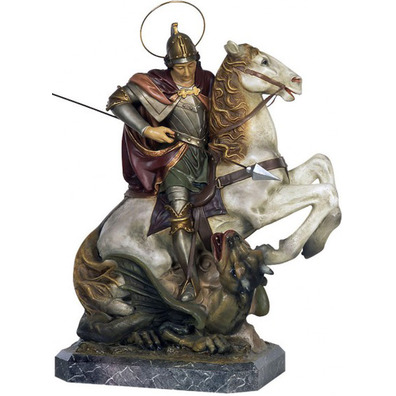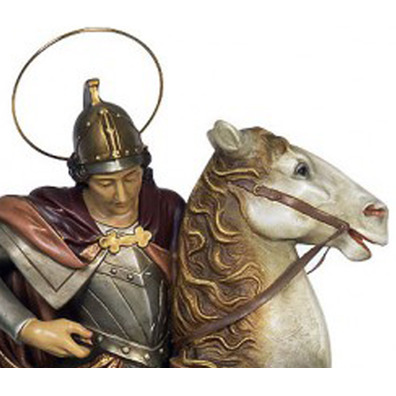Saint George on horseback fights the dragon
5.461,00€
Taxes includedReligious product available on request . Shipping time is approximately 6-10 weeks. For more information about this product, contact to Brabander catholic products.
Image of Saint George and the Dragon
- Image made of pulp wood with glass eyes.
- For sale in 90 and 150 cm.
- Polychrome finish.
- Imitation marble base.
- Saint George is depicted on a white horse fighting the dragon.
- Includes spear and metal halo.
- The Saint is dressed in soldier's armor, helmet and red cape.
Image of Saint George, life of the Saint
Saint George is one of the Saints with the greatest awakened devotion in the whole world.
History tells us that Saint George was a Roman soldier who was born in the city of Cappadocia (in present-day Turkey) around the year 280 AD. C. within a family of Roman nobles settled in the Christian area.
As a child, Saint George loses his father Gerontius, a soldier of the Eastern Roman Empire, and remains in the care of his mother Polychromy, a very religious person who introduces little Saint George to Christian doctrine. His mother, now a widow, decides to return to Lydda, the town where she was born.
It is in this town where Saint George spends his childhood until he decides to become a Roman soldier just like his father had been. Saint George was skillful with arms and brave in combat, which led to a rapid rise in the army. He was assigned to Nicomedia as the personal guard of the Roman Emperor Diocletian.
During the years 302 and 303 d. C. the emperor whom Saint George served promulgated edicts forcing the population to make sacrifices to the Roman gods. Saint George dared to criticize the edicts and the Emperor Diocletian himself, who was angry with the young Christian soldier.
After being arrested, Saint George suffered all kinds of torments for several days in front of the walls of Nicomedia, the town where the Saint resided. After numerous tortures, and seeing the emperor that Saint George did not show any sign of weakness or repentance, Diocletian decided to behead him on April 23, 303 AD. c.
St. George's body, picked up by one of his servants and friends, was taken to Lydda where he was buried. His tomb inscription reads "Saint George, Standard Bearer" in Greek.
Later Emperor Constantine I built a church in honor of the saint.
In our days we continue to celebrate April 23 as Saint George's Day , a festival with a great tradition in Aragon, Catalonia, Valencia and most of the Spanish Levant.
Story of Saint George and the Dragon
The figure of Saint George is closely related to the figure of a dragon. In most of the images and figures that we can see today of Saint George, the Saint is represented bravely facing a dragon.
The origin of the story of Saint George and the dragon dates back to the time when the Saint was in the Roman military.
In the city of Silca there was a lake where a dragon was hiding that had all the inhabitants of the town frightened. This dragon attacked the city where it made great damage. With each attack, the dragon, a powerful and merciless beast, plunged the town into chaos. In addition to these fatal attacks, the dragon gave off a very unpleasant odor that affected animals, plants and people.
To avoid the attacks of the dragon, the inhabitants of Silca agreed that every day they would throw two lambs into the lake where the dragon lived to feed the beast. This solution worked, and the citizens of Silca did not suffer from the dragon's attacks for a while. The time came when lambs became scarce in the region and the locals feared for their lives again.
The neighbors got together and made a fateful decision: a person, chosen at random, would be thrown into the lake with a lamb every day to appease the dragon's hunger.
They did so for a while until the king's daughter came out of the lottery. The sovereign refused to give his daughter to the dragon, but the villagers, who had already lost numerous relatives, forced him to fulfill his obligation and he had to give up the princess.
As the grieving princess was on her way to the lake to give the dragon her last breath, on her way, Divine Providence, put a Christian knight on horseback, Saint George . The Saint, seeing the sad face of the girl, asked her why she was so disconsolate. The princess told her to flee that there was no salvation for her. After consoling the king's daughter, Saint George got the princess to tell him the reason for her sadness. The young woman told him how she had been chosen to give her life to the dragon for Silca's sake. Saint George offered to protect her and kill the dragon.
Saint George and the princess walked to the lake where the dragon lived. Once there the dragon came out to meet him. St. George, commending himself to God, advanced on his horse and aimed his spear at the heart of the beast. The blow was so accurate that it pierced the animal leaving it immobile.
Saint George asked the princess to tie the dragon with her belt and take it to Silca. Once they reached the city, Saint George said that the dragon had been defeated thanks to the will of the one true God. He added that if the townspeople had a Christian baptism it would end the life of the beast.
The people of Silca, admired by the feat of Saint George and the strength that their God had given him, converted to Christianity. Saint George at that moment ended the life of the dragon. The blood that flowed from the beast turned into a red rose that Saint George gave to the princess.
The story of Saint George and the dragon , along with many others of Christian saints and martyrs, were compiled by the Dominican Santiago (or Jacobo) de la Vorágine, Archbishop of Genoa, in the mid-13th century. The work initially titled Legenda Sanctorum ("Lectures on the Saints"), and later known as the "Golden Legend" or "Legenda aurea" (in Latin), reached a great popularity in the Middle Ages.






